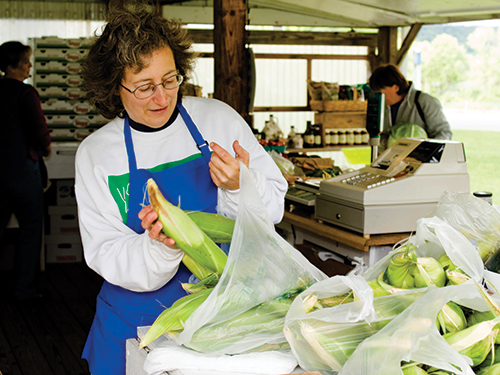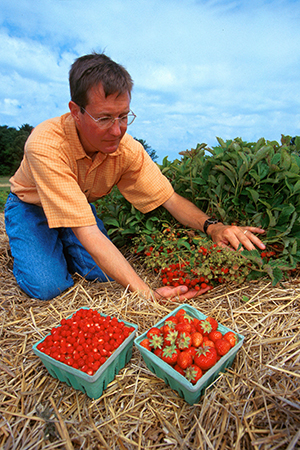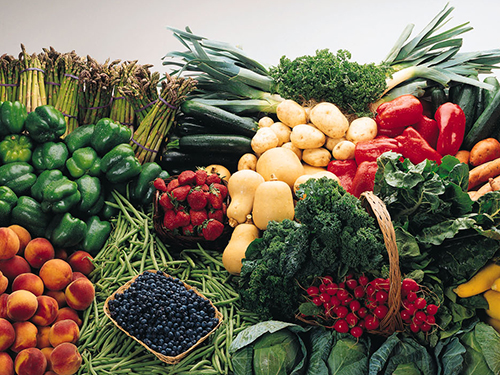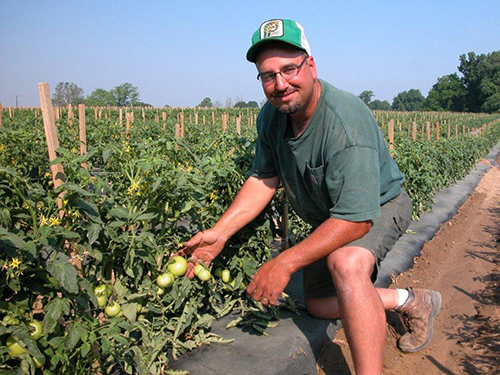
Fact Sheet FS1179
Every three months we adapt to the new seasons heading our way. Fortunately, for us, each new season brings with it a unique abundance of fresh produce that boasts a variety of new flavors and tastes to savor.
More and more, consumers are making the choice to “eat seasonally,” allowing Mother Nature and local agriculture to dictate what they select to eat. “Eating seasonally” means eating a variety of local foods that are in season and at peak flavor shortly after harvest during that particular time of the year. It means making locally grown foods the foundation of daily meals; and making a conscious decision to support local farmers and growers by choosing as many foods as possible from the local state or region.
Along with new flavors and great-tasting opportunities, buying locally grown, in season produce offers many benefits—to you, your community, and even the local economy.
Improving Health and Nutrition
Variety
Variety is not only the spice of life; it’s also the way to a healthier, more nutritious diet. When different produce is available throughout each season, it encourages you to try an assortment of fruits and vegetables, rather than eating the same few, day after day. The greater the variety of fruits and vegetables in your diet, the greater the variety of vitamins, minerals, and phytonutrients you eat.
Quality
The quality of the nutrients in your fruits and vegetables is related to how long produce has been sitting since it was harvested. Food starts to change as soon as it's picked, and delicate nutrients begin to deteriorate with time. When produce is harvested hundreds or thousands of miles away, it travels for days or weeks to get to your market. Once in the market, it sits on a shelf until it is sold. Time, temperature changes, exposure to air, and artificial light all rob fruits and vegetables of valuable nutrients. Locally grown fruits and vegetables reach your plate sooner than those from far away…meaning that the nutrients are preserved and intact.

Freshness
There is an inherent “freshness guarantee” that goes along with buying locally grown produce, whether you purchase it from a farm stand, farmers’ market, or grocery store. When produce is harvested hundreds or thousands of miles away, it is picked before it’s fully matured so it won’t spoil during transport. In season, locally grown produce, on the other hand, tends to be fresher because it is picked at its peak of quality and nutritional value, often the same day you buy it. So, it is ready to eat right away, is at peak nutritional potential, and sits for less time since it doesn’t travel long distances from farm field to the market. It’s fresh. And the fresher the produce, the better it tastes—which makes eating fruits and vegetables more appealing.
Food Safety
Buying locally grown produce offers you the ability to know exactly how and where your produce was grown. You can ask the local farmer at the farmers’ market or farm stand about how they ensure produce safety, their growing practices, the varieties they choose to grow, and freshness. Or, at the grocery store, simply ask the produce manager. Very often, they are familiar with the farmers who grow and supply their local produce.
Conversely, if there is a need to track the origin of your produce due to a food safety scare, locally grown produce is easier to track to ascertain safety than food that has traveled long distances and passed through more handling steps.
Building the Local Economy
Buying local, seasonal produce ensures that the profit from the sale is going right back into the area’s economic system, whether you buy directly from a farmer or from a local store. Whether you shop at the grocery store, farm stand, or farmers’ market, your purchase benefits the area’s economy in several ways:
For Farmers
When farmers sell directly to consumers from a farm stand or farmers’ market, they keep a higher percentage per sale because there is no middleman—you’re buying fresh, seasonal produce directly from the grower. At the grocery store, selling locally grown produce to a much larger audience offers farmers an opportunity to sell larger quantities of produce by reaching more consumers during regular shopping trips.
For the Community
Agriculture is an important part of the quality of life we enjoy. Productive farmland helps keep property taxes down, subsidizes the costs of suburban sprawl and the services associated with residential growth, and adds to a community’s character by providing indirect benefits such as scenic vistas, open space, and wildlife habitats. These attract additional opportunities for tourism, recreation, and outdoor sports, all of which contribute to the area’s economy. Local agriculture also supports local jobs. Thousands of people are employed both seasonally and year-round by farms and agribusinesses. Other local businesses also rely on locally grown products to support their own efforts.
Protecting the Environment
Reducing the distance produce has to travel from field to consumer is also beneficial to our environment. Much of the food sold at our stores today has little connection to the local environment. Consumer demand for produce that comes from farms that are hundreds or thousands of miles away adds to the disconnect many consumers have towards local agriculture and local farmers. By reconnecting to the local food system, we can also promote ecological diversity and protect natural resources.
Conserve
Compared to foods grown in other regions of the United States or in other countries, food that is locally grown does not have to travel far to reach the market’s shelves. Unlike locally grown, food that comes from other states or countries could have traveled 1,300 miles or more before it reaches the market. By definition, locally grown foods require much less fuel and energy to transport, simply because they’re grown nearby, in the same state or region. The cost and use of fuel is greatly reduced when stores stock produce from local farms, which benefits the environment, as well as farmers’ profits and consumer food costs.
Reduce
Just-picked produce is extremely fresh. If sold locally, it does not require special air-tight packaging or transport. This reduces the use of plastic bags and packaging and helps reduce the amount of energy utilized or waste associated with those plastic bags/packages.
Become a Seasonal Eater
Seasonal eating is more than just a way to shop. For many consumers, it’s a frame of mind, a conscious decision to support local farmers, preserve our agricultural heritage, and help the environment while eating the freshest, healthiest fruits and vegetables possible. Use these tips to help take a more seasonal approach to eating:
Make Use of Labels and Signs
Since 2009, stores are required to use Country of Origin Labels (C.O.O.L.) on their produce. These labels can help you learn where your produce was grown. Although C.O.O.L. labels don’t specify state, produce manufacturers are more commonly including stickers, signage, and packages that tell consumers in which state U.S. produce was grown. Likewise, state marketing programs–like Jersey Fresh or Georgia Grown—further identify where produce is grown.
Learn What’s in Season
Whether it’s a grocery store, farmers’ market, or farm stand, it is common to see shelves stocked with a variety of seasonal, local produce and non-local produce, as well. To help find locally grown, in season fruits and vegetables, learn about the area’s growing season. The New Jersey Department of Agriculture’s “Seasonal Produce Availability Chart” is a great resource. Visit the Rutgers New Jersey Agricultural Experiment Station (NJAES) Cooperative Extension’s What’s in Season from the Garden State web site for timely updates on seasonal food tips, produce availability, and locally grown/produced products. Sign up for their e-newsletter, too.
Think Hot and Cool
While fresh produce may be most abundant and widely available during summer, learn about locally grown cool-weather crops, as well. Potatoes, winter squash, carrots, lettuces, cabbage, onions, beets, turnips, apples, and pears are widely available in spring, autumn and winter.
Pick-Your-Own
Several months out of the year we can incorporate activities along with healthy eating. There are a variety of “pick-your-own” farms throughout New Jersey, which allow families to spend time together picking apples, peas, peaches, cherries, pumpkins, berries, potatoes, and more. Not only is it a fun day out with the family, it’s also a way to save money on your food. Picking your own produce is often less expensive than buying already picked produce. And, helping children understand where their food comes from is one way to get them interested in food and encourage them to eat their fruits and vegetables.
Not Just Fresh
Drying, freezing, and canning fruits and vegetables when they’re “in season” are excellent ways to make summer produce last throughout the year, whether you do it yourself or purchase them at the store or farm. Look for juices and ciders made with local produce, too.
Great Links for Seasonal Eating
Check out these websites to find local farms and farmers’ markets, recipes, pick-your-own farms, farm stands, and more:
Jersey Fresh
Wondering how to tell if produce at the market is local? In New Jersey, just look for the words Jersey Fresh. Produce labeled Jersey Fresh indicates that it came from a farm somewhere in New Jersey. The Jersey Fresh program was developed to help showcase the variety of fruits and vegetables available year-round in New Jersey. This helps you buy more seasonally ripe produce when shopping at the supermarket or other produce markets.
Many other states have their own local agricultural promotional marketing campaigns, as well:
These are just some examples of how states are promoting local agriculture and seasonal produce to consumers.

October 2020
Copyright © 2025 Rutgers, The State University of New Jersey. All rights reserved.
For more information: njaes.rutgers.edu.
Cooperating Agencies: Rutgers, The State University of New Jersey, U.S. Department of Agriculture, and Boards of County Commissioners. Rutgers Cooperative Extension, a unit of the Rutgers New Jersey Agricultural Experiment Station, is an equal opportunity program provider and employer.



